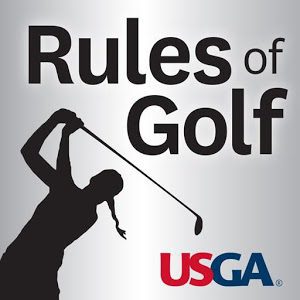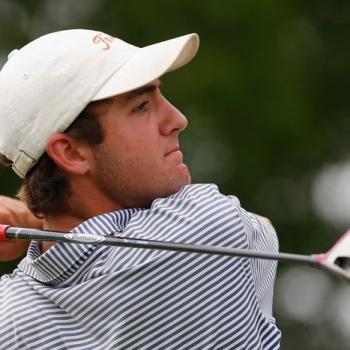 Well, after posting Sunday and today about my apparent error regarding the golf rule about “building a stance,” I learned only minutes later there was a very important announcement today in golf about the rules of the game. It reminded me of what the outspoken yet winsome golfing legend Gene Sarazen once said to me. I was playing with him at Augusta National in the par-three, nine-hole competition that is a tradition on Wednesday before the Masters tournament starts each year. Gene was there because he also continued the tradition of being an aged Masters winner who hits the first ball off the first tee of the first round of the Masters, thus on Thursday morning. Anyway, somehow Gene and I got in a discussion about the Rules of Golf. He said something like this to me, “I quit reading the Rules of Golf a long time ago because they’re always changing them.” The Squire, however, might have approved of what I’ve just learned.
Well, after posting Sunday and today about my apparent error regarding the golf rule about “building a stance,” I learned only minutes later there was a very important announcement today in golf about the rules of the game. It reminded me of what the outspoken yet winsome golfing legend Gene Sarazen once said to me. I was playing with him at Augusta National in the par-three, nine-hole competition that is a tradition on Wednesday before the Masters tournament starts each year. Gene was there because he also continued the tradition of being an aged Masters winner who hits the first ball off the first tee of the first round of the Masters, thus on Thursday morning. Anyway, somehow Gene and I got in a discussion about the Rules of Golf. He said something like this to me, “I quit reading the Rules of Golf a long time ago because they’re always changing them.” The Squire, however, might have approved of what I’ve just learned.
The USGA and the R&A announced today that there will be a wholesale change in the Rules of Golf to be implemented at the beginning of 2019. They say there has been no such change of this magnitude for over thirty years. Suggestions will be received until the end of August this year. Then officials will take time in crafting the new rules. Their three main objectives will be to reduce the number of rules, simplify them so that they will be more understandable, and speed up play.
The United States Golf Association and the Royal and Ancient Golf Club are the only two rules-governing bodies in golf world. They have been working in tandem together on the Rules of Golf for about half a century. Before that, it wasn’t so. Now, they have proposed some important new rules changes which are not yet permanent. There are presently 34 rules in the rulebook, and they intend to reduce them to 24. Some of the more prominent changes will include the following, with my comments appended:
(1) You can ground your club and remove loose impediments in a hazard without penalty. I think this may be an improvement. It can be difficult for a player to know that s/he grounds the club while in the process of addressing the ball and even taking a backswing. The story about Arnold Palmer playing a provisional ball for an embedded ball on the 12th hole in the last round of the 1958 Masters is well known. Palmer’s playing partner was Ken Venturi, who lost the tournament to Palmer (his first Masters win). Ken claimed Arnold did not announce he would play a second ball prior to hitting his first ball from the embedded lie. According to the Rules of Golf, then and now, you must announce that before playing that first ball. Arnold claimed that he told the rules official prior to playing his embedded shot that that was his intention. But there was another, and later, Masters controversy in which Arnold Palmer was involved that relates to this new rule change being proposed. Arnold hit a sand bunker shot, and the ball remained in the bunker. In anger, Arnie quickly struck the sand with his club. Since his ball was still in the bunker, that was an infraction since you could not ground your club anywhere in a sand bunker prior to making a stroke from it. Then Masters rules officials asserted themselves and ruled that Arnold had not broken that rule because he had not intended to test the sand, and they thought that was the purpose of the rule. I remember the PGA Tour pros being upset about that because Arnold certainly would have been penalized by our officials. But the Masters is not run by the PGA Tour. In fact, on the PGA Tour all four majors are not run by the PGA Tour and thus officiated by PGA Tour officials.
(2) When dropping a ball for any of various reasons, which will then be in play, the player no longer must drop it from shoulder height but can drop it even one inch from the playing surface. This seems rather strange to me. But I will say that dropping a ball from shoulder height can be unfair since it can plug in wet or muddy conditions.
(3) If a player searches for his/her ball and inadvertently moves it, or accidentally moves a ball or ball marker on the green, there will be no penalty. Previously, when a player accidentally touched or hit her/his ball lying in the rough with his/her person or a club while searching for it, there was no penalty if it happened accidentally. But that can be difficult to prove. This is a good rule change that has been long needed.
(4) The five-minute maximum stipulation for searching for a lost ball will be changed to three minutes. I suspect many golfers will object to this rule change. Obviously, this rule change is being proposed to speed up play.
(5) There will be no penalty for relief from an embedded ball anywhere (except in a sand bunker), thus not only on a fairway or green as presently. I like this. But there will be no change regarding a ball that comes to rest in a divot mark on a fairway. Jack Nicklaus has always been quite vocal in opposing this rule even since, I think, during his amateur days. I have always agreed with Jack about this, since it seems so unfair.
(6) Almost any damage can be repaired on the line of putt before putting, and this without penalty. Thus, shoe spike marks can be repaired. Oh man! I wish I could have done that on the seventh hole at Pebble Beach when I was leading the last round of the U.S. Open in 1972. Nicklaus, who won, was standing on the tee watching me miss an 18 inch putt for a three-putt because the ball hit a big spike mark in my line. In my day, when we wore golf shoes with metal spikes, since plastic spikes came along in the 1990s, this would have been the most significant rule change they are now proposing. Occasional hack golfers and non-golfers used to be surprised to learn that tapping down those spike marks was a big infringement on the Rules of Golf.
(7) A player will be penalized one stroke if s/he takes more than forty seconds to play once s/he has arrived at her/his ball and has the honor. Previously, there had been no time stipulation for playing a shot. This is a very good rule change. It will be the main proposed rule that will speed up play. The popularity of golf has always suffered from the fact that a usual round of 18 holes of golf takes about four hours, which is too long and thus at a disadvantage with other sports. This proposed rule change follows the PGA Tour, which implemented this special rule for its competitions several decades ago. But there is a problem with this rule just as there is for the maximum time stipulation for searching for a lost ball. That is, who is counting? Thus, it will be difficult to enforce. On the PGA Tour, they have several rules officials who move about the course, watching for slow play. Golfers can be very unaware of how much time transpires when they are surveying the landscape, testing the wind, selecting their club, and otherwise preparing to play. If this rule goes into effect, it will cause policing among players. Will we see stop watches sold in the pro shops? I can envision a player holding up a watch and saying to the player whose turn it is to play, “heh buddy, you’re on the clock.”
(8) A caddy will no longer be permitted at any time to stand behind his/her player’s ball on an extension of its line to the target while that player is taking his or her stance. Previously, there has been no rule against this, only that the caddy must then stand aside before the player makes a stroke. Of course, few golfers nowadays have caddies. So, this rule will apply especially to Touring pros. Caddies usually do this to line up their players. I’ve never thought about this before as a rule change. My initial reaction is that this is a good, fair rule change. It also will speed up play a little.
(9) A player may use a damaged club no matter how it became damaged. Previously, a player could use a club that s/he had damaged in the course of play of that round of golf, but not if the player had damaged the club in a fit of anger. I think this is a good rule change, but it might cause golfers to be less restricted with their anger. LOL! This rule change is a slight move away from golf being “the gentleman’s game.” Sorry ladies; I guess I’m old fashioned. Maybe we should call it “the gentle game;” but not with this rule change.
(10) Finally, if a player’s ball in motion accidentally hits the player, his or her caddie, the person attending the flagstick, or the attended or removed flagstick, there will be no penalty. Previously, there had been a one stroke penalty for all of these events. I think this proposed rule change needs some cleaning up if it should be enacted at all. Why? It all has to do with intent. A caddie could intentionally do any of these things and thereby aid his/her player. For example, a caddie could attend the flagstick for his or her player, and when the ball approaches merely lay the flagstick down on the green, right behind the hole, as a backstop. Who hasn’t ever thought of that. All of us kid golfers did that. Oh, it would be nice to be a kid again, playing the game of golf. And beginning in 2019, kid golfers might be able to say they now understand the rules of the game. Moreover, maybe some of us old guys could even say that, for instance, about “building a stance.”














